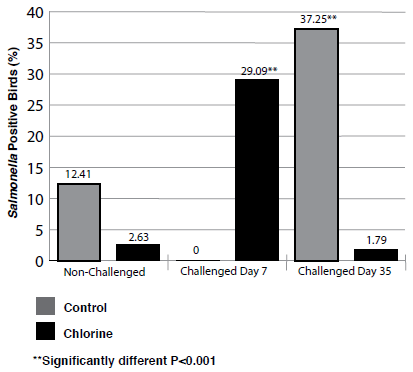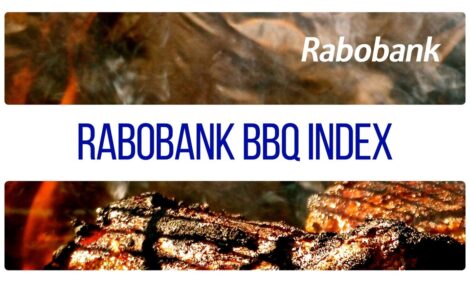



Chlorination/Acidification Affects Salmonella Contamination
Studies at the University of Arkansas demonstrated that chlorinated water reduces the incidence of Salmonella spp. when broilers are challenged close to market age but not when challenged at seven days of age. Authors Jennifer Hughes, Brookee Dean, Tyler Clark and Susan Watkins also stressed the importance of monitoring oxidation reduction potential in their article in the University's Avian Advice.Introduction
Salmonella contamination continues to be problematic for the poultry industry. Contamination can occur at any production or processing step and in live production Salmonella control is difficult because treatments can influence production characteristics, and, in turn, financial returns. Fortunately, many good management practices are also effective Salmonella control methods.
Water has long been known to be a vehicle for the transmission of bacterial, viral and protozoal diseases of poultry, including Salmonella. Indeed, researchers have verified that when birds consumed water containing fecal coliform levels of 106, 105, 104, 103, 102 and 10, Salmonella was isolated from 100 per cent, 99 per cent, 66 per cent, 33 per cent, 21 per cent and 11 per cent of the birds, respectively (Amaral, 2004). Even though the widespread adoption of closed, nipple drinker systems has reduced a good deal of contamination once passed from bird to bird, water chlorination alone may have little effect on cecal Salmonella levels for artificially inoculated birds consuming the water (Poppe et al., 1986). In addition, Salmonella may be isolated from 7 to 8 per cent of water samples collected from nipple drinker systems and (Heyndrickx et al., 2002).
Many investigations of the potential effects of water chlorination on Salmonella have ignored the influence of oxidation-reduction potential (ORP). Yet, enhancing the ORP level by reducing the pH can significantly affect water disinfectants effectiveness (particularly chlorine) (Suslow, 2004). Consequently, a trial was undertaken to determine if free chlorine of . 1 ppm free chlorine and acidified calcium sulfate (ACS) also injected at a rate necessary to maintain .650 mV oxidation reduction potential (ORP) affected Salmonella contamination in artificially inoculated broilers.
The sense of taste in chickens has been studied for decades and birds perceive taste entirely differently than humans. Flavors objectionable to most humans may or may not be accepted by chickens (Kare et al., 1957). The domestic chicken has definite likes and dislikes with respect to water taste. In fact, early studies suggest that birds are much more sensitive to flavors in water than those in feed (Kare and Pick, 1960). Virtually every production professional realizes that feed and water consumption are closely correlated…or…more directly – if they aren’t drinking, they aren’t eating. Early studies show that birds reject certain flavors: such differences may be easily detected because of the dramatic decrease in water consumption. However, birds tend to adapt to other flavors and can eventually accept them as “normal.”
The data in Figure 1 were collected by Kare et al., (1957) and illustrate one adaptation method employed by birds. These researchers placed two chick watering jars in each pen. One jar contained untreated water and the other contained flavored water. A comparison of the amount of water consumed from the two jars measured acceptance or rejection of flavors by the birds. The data in Figure 1 are similar to those observed in field situation when acidified calcium sulfate (ACS) is included in drinking water for poultry.

Materials and Methods
To measure the effectiveness of chlorination on Salmonella in broilers, two water regimes were designed, one, the treatment, with chlorination and the other, a control, without chlorination. For the chlorination treatment, an inline gas chlorinator was installed and set to maintain .1 part per million (ppm) free chlorine along with a second injector that injected a food grade acid, acidified calcium sulfate, (ACS) to assure that an ORP reading of 650 mV or higher was maintained. The ORP, total and free chlorine levels were measured and recorded during four times daily.
Thirty (30) birds were placed in each of 16 pens and were raised under standard commercial conditions using nipple drinkers and tube feeders. Birds were housed in a solid-sidewall house with a minimum ventilation system and environmental controls and water regimes were given from 0 to 42 days of age. All birds were fed a dietary program based on the Cobb-Vantress nutritional recommendations. All birds were fed a pelleted diet; the starter diet was also crumbled. On day 7 of the trial, 3 pens of birds in each of the two water regimes were randomly selected and within each pen, 10 birds were marked with wing bands and challenged with Nalidixic acid resistant Salmonella typhimurium (NAL-SAL). On day 35, a second set of 3 pens for each water regime were selected and 10 birds were again marked with wing bands and challenged with NAL-SAL. The remaining 2 pens per water regime were not challenged and served as the controls.
On day 42, 10 of the NAL-SAL challenged birds per pen along with 5 of their non-challenged pen mates were sacrificed by asphyxiation with carbon dioxide gas and the ceca aseptically removed. In addition, 10 birds per pen from the non-challenged pens for each regime were also sacrificed to determine NAL-SAL incidence.
Results
No statistical differences were found when the weights, feed conversions and mortality percentages of bird given chlorinated water were compared with those receiving water with no chlorine (data not shown). The data in Figure 2 summarize the findings of this study. No significant differences among treatments for non-challenged birds. In birds challenged with Salmonella at 7 days, more birds that drank chlorinated water were found contaminated as compared to birds given water with no chlorine. However, when challenged with Salmonella at 35 days, less contamination was found in birds drinking chlorinated water than in birds drinking water with no chlorine.

Discussion
Results of this study indicate that chlorinated water does not provide protection against early exposure (challenged at 7 days) to Salmonella spp. while chlorinated water maintained at an ORP of 65 mV or higher does reduce the incidence of Salmonella spp. when birds are challenged close to market age (challenged at 35 days). Lack of protection and actual increase in Salmonella incidence in chlorinated birds challenged at the early age is perplexing but might be related to acidifier used in these trials.
To illustrate the possible connection, consider the following observations on bird performance at the University of Arkansas’ Division of Agriculture Applied Broiler Research Farm (ABRF). ABRF has utilized gas chlorine and acidifiers for its last 13 flocks. Average bird weights for these flocks have remained near the top of the settlement with the exception of three flocks which received the acidified calcium sulfate instead of the usual acidifier, sodium bisulfate. The average weight for these two flocks was below average. For the next 2 flocks, the acidified calcium sulfate was replaced with the sodium bisulfate and weights again were near the top of the settlement. These flocks were grown near the time this project was conducted so the potential that the acidifier could impact water consumption was not discovered in time to choose another acid product for the project. The acidified calcium sulfate may have depressed water consumption early on which is reflected in the lighter weights of the chlorinated birds though not significant at day 21 in either trial. The depressed weights for the birds on the chlorination regime in this experiment could be a reflection of depressed water consumption in the young birds and this would also mean a depressed feed consumption which may have allowed the Salmonella challenge at 7 days of age to be more infective. It has been proven that birds off feed do have an increase in gut pH and this would result in more favorable conditions for Salmonella colonization for chicks exposed to the microbe (Hinton et al,).
The fact that the chlorination/acidification treatments did significantly reduce the incidence of Salmonella in birds challenged at 35 days of age does make chlorination and water acidification which maintains a .650 ORP level along with >1 ppm free chlorine worth exploring further as an on-farm control option for Salmonella. It is interesting to note that birds in the other project which were drinking the ACS water were drinking 2-4 gallons more per thousand birds around day 35 versus the birds consuming the SBS water. Since this is data from three flocks, it is safe to assume that water consumption at day 35 during this trial was not below normal consumption for the birds drinking the ACS/chlorinated water and therefore even though these birds were exposed to Salmonella, the more potent chlorine sanitizing residual helped reduce Salmonella colonization. One of the primary lessons learned in this project was how critical it is to monitor chlorine and ORP values when chlorine is used for water sanitation, as it affects water and feed consumption, efficacy of Salmonella treatments in water and in the final analysis, total bird performance and grower revenues. A second thought is the need to choose products including acids which will not impair water consumption any time during the bird’s life cycle. This may require producers and company personnel to evaluate more than one product such as acids in order to find the best fit.
References
Amaral, L. A., 2004. Drinking water as a risk factor to poultry health. Brazilian Journal of Poultry Science 6(4):191- 199.
Barton, L. 1996. Relevance of water quality to broiler and turkey performance. Poultry Sci. 75:854-856.
Carter. Thomas A. and Ronald Sneed, no date. Drinking water quality for poultry. Poultry Science and Technology. Published by The North Carolina Agricultural Extension Service.
Damron, B.L., M.D. Ouart, R.B. Christmas and W.D. Graham, Florida broiler farm water quality survey.
Gauger, H. C. and R. E. Greaves, 1946. Isolation of Salmonella Typhimurium from drinking water in an infected Environment. Poultry Science25: 476-478.
Heyndricks, M., D. Vanderkerchove, L Herman, I. Rollier, K. Grijspeerdt and L. Dezutter. 2002. Routes for Salmonella contamination of poultry meat: epidemiological study from hatchery to slaughterhouse. Epidemiol. Infect. 129:253-265.
Hinton, A., R.J. Buhr, K.D. Ingram. 2000. Physical, chemical and microbiological changes in the grop of broiler chickens subjected to incremental feed withdrawal. J. Poult. Sci. 79: 212-218
Poppe, C., D. A. Barnum and W. R. Mitchell. 1986. Effect of chlorination of drinking water on experimental Salmonella infection in poultry. Avian Diseases 30(2):362-369.
SAS Institute. 2005. SAS User’s Guide. Version 8.1. SAS Institute, Inc., Cary, NC
Sawyer, C.N., P.L. McCarty, L. Parkin, and G.F. Parkin. 1994. Chemistry for Environmental Engineering, fourth edition. McGraw Hill, Inc. New York, N.Y.
Suslow, T.V., G. Peisor, X. Nie, J. Wu, M. Zunegas and M. Cantwell, 1999. Validation of oxidation-reduction potential in postharvest water disinfection monitor, control and documentation systems for fresh and minimally processed fruits and vegetables. Institute of Food Technology Annual meeting.
Suslow, T. V. 2004. Oxidation-reduction potential (ORP) for water disinfection monitoring, control and documentation. University of California, Division of Agriculture and Natural Resources Publication no. 8149
White, Geo. Clifford, 1999. Handbook of chlorination and alternative disinfectants. Wiley-Interscience Publication.








